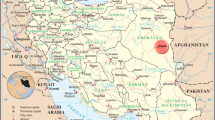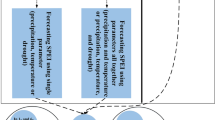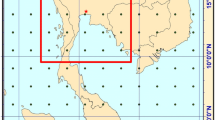Abstract
A tropical cyclone (TC) precipitation prediction scheme has been developed based on the physical quantities of the NCEP/NCAR reanalysis data as potential predictors and using fuzzy neural network (FNN) model. TC precipitation samples from 172 tropical cyclones (TCs) affecting Guangxi, China, spanning 1980–2015 are used for model development. The FNN model input is constructed from potential predictors by employing both a stepwise regression method (SRM) and a locally linear embedding (LLE) algorithm. The LLE algorithm is capable of finding meaningful low-dimensional architectures hidden in their nonlinear high-dimensional data space and separating the underlying factors. In this scheme, the newly developed model, which is termed the FNN–LLE model, is used for daily TC precipitation prediction from 20:00 (Beijing Time, or BT) of the previous day to 20:00 BT of the current day at 89 stations covering Guangxi, China. Using identical modeling samples and independent samples, predictions of the FNN–LLE model are compared with the widely used SRM and interpolation method using the fine-mesh data of the European Centre for Medium-Range Weather Forecasts (ECMWF) in terms of the performance of TC rainfall prediction at 89 stations in Guangxi. The root-mean-square error (RMSE), bias, and equitable threat score (ETS) results were employed to assess the predicted outcomes. Results show that the FNN–LLE model is superior to the interpolation method by ECMWF and SRM for TC precipitation prediction with RMSE values of 21.94, 24.07, and 25.22 in FNN–LLE model, interpolation method by ECMWF and SRM, respectively. Moreover, FNN–LLE model having average bias and ETS values close to 1.0 gave better predictions than did the interpolation method by ECMWF and SRM.






Similar content being viewed by others
Abbreviations
- BIAS:
-
Bias score
- BPNN:
-
Back-propagation neural network
- ECMWF:
-
European Centre for Medium-Range Weather Forecasts
- ETS:
-
Equitable threat score
- FNN:
-
Fuzzy neural network
- FNN–LLE:
-
FNN with employing both stepwise regression method and LLE algorithm for constructing model input
- Guangxi:
-
Guangxi Zhuang Autonomous Region, China
- LLE:
-
Locally linear embedding
- MDS:
-
Multidimensional scaling
- NWP:
-
Numerical weather prediction
- PCA:
-
Principal component analysis
- RMSE:
-
Root-mean-square error
- SRM:
-
Stepwise regression method
- TC:
-
Tropical cyclone
- TCs:
-
Tropical cyclones
References
Chen G-Y, Ding X-X, Zhao L-Y (2005) An automatical pattern recognition techniques of cloud based on fuzzy neural network. Chin J Atmos Sci 29:837–844 (in Chinese)
Chen J-F, Yuan B-Z, Pei B-N (2008) Face recognition using two dimensional laplacian eigenmap. J Electron 25:616–621
Ebert EE, Damrath U, Wergen W, Baldwin ME (2003) The WGNE assessment of short-term quantitative precipitation forecasts. Bull Am Meteorol Soc 84:481–492
Guangxi Climate Center (2007) The climate of the Guangxi Zhuang autonomous region. China Meteorological Press, Beijing, p 60
Han X, Yang Y, Feng J, Yuan Q (2017) Soybean pest diagnosis based on optimized weights of fuzzy neural network. J Agric Mech Res 3:247–252
Huang Y, Jin L (2013) A prediction scheme with genetic neural network and isomap algorithm for tropical cyclone intensity change over western north pacific. Meteorol Atmos Phys 121:143–152
Huang X-Y, Shi X-M, Liu S-D, Jin L (2009) Research and applying of forecasting tropical cyclone intensity based on fuzzy neural network. Plateau Meteorol 28(6):1408–1413
Huang Y, Jin L, Huang X, Shi X, Jin J (2014) An artificial intelligence ensemble prediction scheme for typhoon intensity using the locally linear embedding. Meteorol Mon 40:806–815
Jian G, Shieh S, McGinley JA (2003) Precipitation simulation associated with Typhoon Sinlaku (2002) in the Taiwan area using the LAPS diabatic initialization for MM5. Terr Atmos Ocean Sci 14:261–288
Jin L, Kuang X, Huang H, Qin Z, Wang Y (2004) Study on the overfitting of the artificial neural network forecast model. Acta Meteorol Sin 62(1):62–70
Kalnay E, Kanamitsu M, Kistler R, Collins W, Deaven D, Gandin L, Iredell M, Saha S, White G, Woollen J, Zhu Y, Leetmaa A, Reynolds R, Chelliah M, Ebisuzaki W, Higgins W, Janowiak J, Mo KC, Ropelewski C, Wang J, Jenne Roy, Joseph Dennis (1996) The NCEP/NCAR 40-year reanalysis project. Bull Am Meteorol Soc 77:437–470
Konrad II, Charles E, Baker Perry L (2009) Relationships between tropical cyclones and heavy rainfall in the Carolina region of the USA. Int J Climatol 30:522–534
Kruse R (2008) Fuzzy neural network. Scholarpedia 3:6043
Kwong KM, Wong MHY, Liu NKJ, Chan PW (2012) An artificial neural network with chaotic oscillator for wind shear alerting. J Atmos Ocean Technol 29:1518–1531
Lee C-S, Huang L-R, Shen H-S, Wang S-T (2006) A climatology model for forecasting typhoon rainfall in Taiwan. Nat Hazards 37:87–105
Li RCY, Zhou W (2015) Interdecadal changes in summertime tropical cyclone precipitation over Southeast China during 1960–2009. J Clim 28:1494–1509
Li Q, Lan H, Chan JCL, Cao C, Li C, Wang X (2015) An operational statistical scheme for tropical cyclone induced rainfall forecast. J Trop Meteorol 21:101–110
Lin G-F, Chen L-H (2005) Application of artificial neural network to typhoon rainfall forecasting. Hydrol Process 19:1825–1837
Lonfat M, Rogers R, Marchok T, Marks FD Jr (2007) A parametric model for predicting hurricane rainfall. Mon Weather Rev 135:3086–3097
Lund IA (1971) An application of stagewise and stepwise regression procedures to a problem of estimating precipitation in California. J Appl Meteorol 10:892–902
Marchok T, Rogers R, Tuleya R (2007) Validation schemes for tropical cyclone quantitative precipitation Forecasts: evaluation of operational models for U.S. landfalling cases. Weather Forecast 22:726–746
McBride JL, Ebert EE (2000) Verification of quantitative precipitation forecasts from operational numerical weather prediction models over Australia. Weather Forecast 15:103–121
Roweis ST, Saul Lawrence K (2000) Nonlinear dimensionality reduction by locally linear embedding. Science 290:2323–2326
Schaefer JT (1990) The critical success index as an indicator of warning skill. Weather Forecast 5:570–575
Shi X-M, Jin L, Zhu Y (2009) A fuzzy neural network precipitation model based on rough set. Comput Simul 26:178–180
Si J-P, Ma J-C, Niu J-H, Wang E-M (2017) An intelligent fault diagnosis expert system based on fuzzy neural network. J Vib Shock 36:164–171
Taniguchi A, Shige S, Yamamoto MK, Mega T, Kida S, Kubota T, Kachi M, Ushio T, Aonashi K (2013) Improvement of high-resolution satellite rainfall product for Typhoon Morakot (2009) over Taiwan. J Hydrometeorol 14:1859–1871
Wang S-T (1998) Neural fuzzy systems and its applications. Beihang University Press, Beijing
Wei C-C (2012) Wavelet support vector machines for forecasting precipitation in tropical cyclones: comparisons with GSVM, regression, and MM5. Weather Forecast 27:438–450
Xinhuanet News (2014) Super typhoon Rammasun batters China, killing 14. Accessed 19 July 2014
Xinhuanet News (2014) Death toll from super typhoon Rammasun rises to 17 in China. Accessed 20 July 2014
Xu A-B, Guo P (2006) Isomap and neural networks based image registration scheme. Adv Neural Netw ISNN 3972:486–491
Ying M, Zhang W, Hui Y, Xiao-qin L, Feng J, Fan Y-X, Zhu Y-T, Chen D-Q (2014) An overview of the China meteorological administration tropical cyclone database. J Atmos Ocean Technol 31:287–301
Yip ZK, Yau MK (2012) Application of artificial neural networks on North Atlantic tropical cyclogenesis potential index in climate change. J Atmos Ocean Technol 29:1202–1220
Yu B, Feng M, Chen B (1996) The application of fuzzily neural network to picture recognition of typhoon clouds. Meteorol Mon 22:22–25
Yue C (2009) A quantitative study of asymmetric characteristic genesis of precipitation associated with Typhoon Haitang. Chin J Atmos Sci 33:51–70 (in Chinese)
Zadeh LA (1965) Fuzzy sets. Inf Control 8(3):338–353
Zhang F, Weng Y, Kuo Y-H, Whitaker JS, Xie B (2010) Predicting Typhoon Morakot’s catastrophic rainfall with a convection-permitting mesoscale ensemble system. Weather Forecast 25:1816–1825
Zhao H, Jin L, Huang Y, Jin J (2014) An objective prediction model for typhoon rainstorm using particle swarm optimization: neural network ensemble. Nat Hazards 73:427–437
Acknowledgments
This work was supported by the National Natural Science Foundation of China (Grant 41575051, Grant 41765002 and Grant 41565005), and the Program of Guangxi Meteorological Service (Grant 2017M08 and Grant 2016Z03).
Author information
Authors and Affiliations
Corresponding author
Rights and permissions
About this article
Cite this article
Huang, Y., Jin, L., Zhao, Hs. et al. Fuzzy neural network and LLE Algorithm for forecasting precipitation in tropical cyclones: comparisons with interpolation method by ECMWF and stepwise regression method. Nat Hazards 91, 201–220 (2018). https://doi.org/10.1007/s11069-017-3122-x
Received:
Accepted:
Published:
Issue Date:
DOI: https://doi.org/10.1007/s11069-017-3122-x




